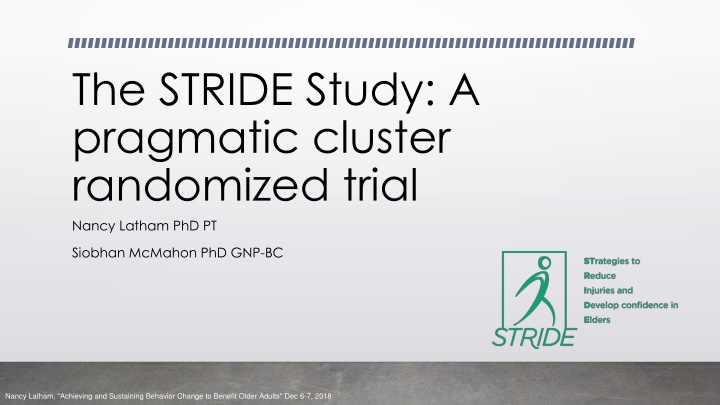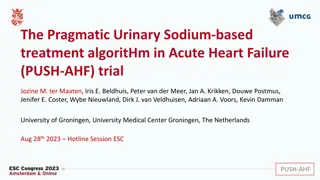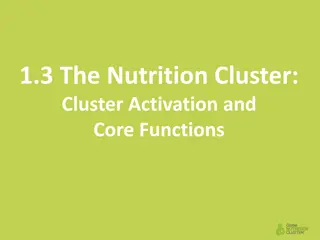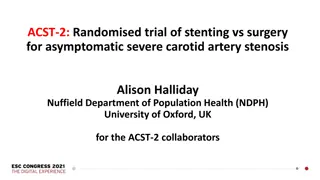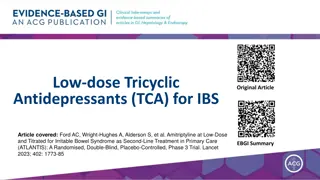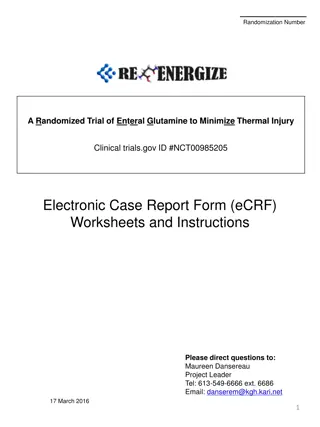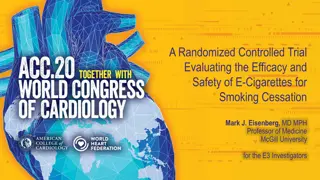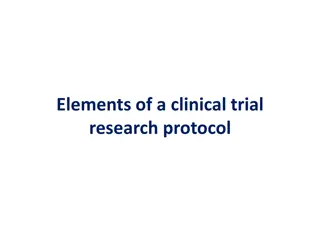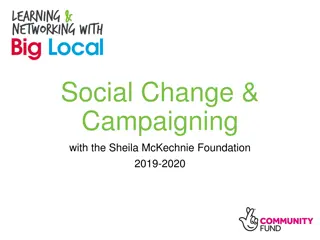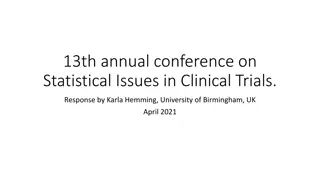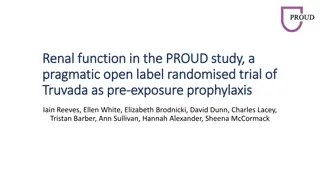The STRIDE Study: A Pragmatic Cluster Randomized Trial - Achieving Behavior Change for Older Adults
"The STRIDE Study is a pragmatic trial aimed at improving older adults' behavior to prevent serious fall-related injuries. Funded by PCORI and NIA, this trial involves 86 clinics and 5451 patients across 10 research sites. Learn about the intervention, study design, and clinical trial sites."
Download Presentation

Please find below an Image/Link to download the presentation.
The content on the website is provided AS IS for your information and personal use only. It may not be sold, licensed, or shared on other websites without obtaining consent from the author.If you encounter any issues during the download, it is possible that the publisher has removed the file from their server.
You are allowed to download the files provided on this website for personal or commercial use, subject to the condition that they are used lawfully. All files are the property of their respective owners.
The content on the website is provided AS IS for your information and personal use only. It may not be sold, licensed, or shared on other websites without obtaining consent from the author.
E N D
Presentation Transcript
The STRIDE Study: A pragmatic cluster randomized trial Nancy Latham PhD PT Siobhan McMahon PhD GNP-BC Nancy Latham, "Achieving and Sustaining Behavior Change to Benefit Older Adults" Dec 6-7, 2018
STRIDE Study Design Outline STRIDE Intervention Preliminary Intervention Implementation Data Next Steps and New Questions Nancy Latham, "Achieving and Sustaining Behavior Change to Benefit Older Adults" Dec 6-7, 2018
The Strategies to Reduce Injuries and Develop Confidence in Elders (STRIDE) Study Funders: Patient-Centered Outcomes Research Institute (PCORI) and National Institute on Aging Pragmatic trial designed to answer: Can redesigning health care practices and engaging patients to improve quality reduce serious falls-related injuries and improve other outcomes? Nancy Latham, "Achieving and Sustaining Behavior Change to Benefit Older Adults" Dec 6-7, 2018
Cluster-randomized, parallel group superiority trial with practices stratified by healthcare system and patients nested within practices Unit of randomization is the practice (clinics) 86 clinics and 5451 patients recruited from across 10 research sites over 20 months with 24 months of follow-up (maximum follow up =44 months) Design Clinics randomized to 1 of 2 conditions STRIDE Intervention Enhanced practice (education about falls prevention and increased access to CDC published fall prevention resources) Primary Outcome: Serious fall-related injuries Nancy Latham, "Achieving and Sustaining Behavior Change to Benefit Older Adults" Dec 6-7, 2018
STRIDE Clinical Trial Sites Mercy Health System University of Iowa Des Moines, IA Michigan Medicine University of Michigan Ann Arbor, MI Essentia Health Duluth, MN Partners HealthCare Boston, MA Reliant Medical Group Worcester, MA Mt. Sinai Health System New York, NY Johns Hopkins Medicine Baltimore, MD University of Pittsburgh Medical Center Pittsburgh, PA HealthCare Partners El Segundo, CA University of Texas Medical Branch at Galveston Galveston, TX Nancy Latham, "Achieving and Sustaining Behavior Change to Benefit Older Adults" Dec 6-7, 2018
STRIDE Patients Community dwelling persons 70 years of age or older One or more risk factors for falls Fallen and hurt self in the past year Fallen 2 or more times in the past year Fear of falling because of balance or gait Nancy Latham, "Achieving and Sustaining Behavior Change to Benefit Older Adults" Dec 6-7, 2018
The STRIDE Intervention Falls Care Management (FCM) Processes Primary providers and clinic staff Co-create and approve how FCM processes will be operationalized locally Approve and/ or contribute to individualized care plans Co-manage fall risk Clinical and community resources Referral sources for specific risks (e.g., physical therapy, medication therapy management ) Community based resources for specific risks (e.g., group exercise program that includes balance- challenging and leg-strengthening movements) Evidence based fall risk assessment and treatment Chronic care model Self-management Patient centered Motivational interviewing spirit and basic tactics Empirical and Theoretical Foundation Protocol guided Nurse delivered in primary care settings Assessment (7 primary fall risks) Elicit Patient preferences Provide counseling/ information about fall reducing behaviors Co-create, individualized fall- reducing plan of care Co-evaluation and refinement of individualized care plan annually (minimum) Interdisciplinary Collaboration Nancy Latham, "Achieving and Sustaining Behavior Change to Benefit Older Adults" Dec 6-7, 2018
Medication risks 1, 2 1. Postural hypotension1,2 2. Visual impairment11,2 3. STRIDE Intervention Risk Factors Feet and footwear problems 1 4. Osteoporosis, calcium and vitamin D1,2 5. Reducing most of these risks requires behavior change among patients at risk 1and, often, health care provider/ prescriber.2 Strength, gait, and balance disorders 1,2 6. Home safety risks 1,2 7. Nancy Latham, "Achieving and Sustaining Behavior Change to Benefit Older Adults" Dec 6-7, 2018
Risk factor % STRIDE patients with this risk* 100 Which fall risk factors are common among STRIDE patients ? Strength gait balance problems Osteoporosis 92 64 51 24 17 12 Visual impairment Foot and footwear problems Medication risks Home safety risks Postural hypotension *percent of patients in the intervention arm of STRIDE whose assessments revealed the presence of these risks Nancy Latham, "Achieving and Sustaining Behavior Change to Benefit Older Adults" Dec 6-7, 2018
Risk factor % STRIDE patients with risk that also prioritized risk* Which fall risk factors do STRIDE patients prioritize (e.g., choose to learn about and consider treatment options)? Strength gait balance problems Osteoporosis 89 66 84 Visual impairment Foot and footwear problems Medication risks 73 34 65 92 Home safety risks Postural hypotension *percent of patients in the intervention arm of STRIDE, with this positive risk factor who prioritized it Nancy Latham, "Achieving and Sustaining Behavior Change to Benefit Older Adults" Dec 6-7, 2018
Risk factor % STRIDE patients acted on this risk Which fall risk factors do STRIDE patients agree to act on? Strength gait balance problems Osteoporosis 70 43 40 22 6 9 7 Visual impairment Foot and footwear problems Medication risks Home safety risks Postural hypotension *percent of patients in the intervention arm of STRIDE who self-reported action(s) to reduce risk Nancy Latham, "Achieving and Sustaining Behavior Change to Benefit Older Adults" Dec 6-7, 2018
Next Steps New Questions (e.g., future research) What behavior strategies/techniques will most efficiently& effectively lead to changes in fall- reducing behavior . at what doses and for whom? Intervention ends November 30, 2018 Main study results April 2020 Analyze effects of 2 STRIDE conditions on primary outcome of serious fall related injuries What are the linkages between behavior change strategies, psychosocial mechanisms of change, and behavioral outcomes? Analyze intervention processes Ancillary study to examine contextual and cultural factors influencing intervention implementation Secondary analysis to describe patient risks, priorities and actions over time Secondary analyses to explore intervention effects among sub-groups of patients Role of technology in supporting behavior change? Nancy Latham, "Achieving and Sustaining Behavior Change to Benefit Older Adults" Dec 6-7, 2018
STRIDE References STRIDE website: http://www.stride-study.org/ Bhasin, S., Gill, T. M., Reuben, D. B., Latham, N. K., Gurwitz, J. H., Dykes, P., ... & Basaria, S. (2017). Strategies to Reduce Injuries and Develop Confidence in Elders (STRIDE): a cluster-randomized pragmatic trial of a multifactorial fall injury prevention strategy: design and methods. The Journals of Gerontology: Series A. Reuben, D. B., Gazarian, P., Alexander, N., Araujo, K., Baker, D., Bean, J. F., ... & Leipzig, R. M. (2017). The Strategies to Reduce Injuries and Develop Confidence in Elders Intervention: Falls Risk Factor Assessment and Management, Patient Engagement, and Nurse Co management. Journal of the American Geriatrics Society, 65(12), 2733-2739 Nancy Latham, "Achieving and Sustaining Behavior Change to Benefit Older Adults" Dec 6-7, 2018
Questions? nklatham@bwh.harvard.edu @Nancy_K_Latham Nancy Latham, "Achieving and Sustaining Behavior Change to Benefit Older Adults" Dec 6-7, 2018
The Chronic Care Model Extra Nancy Latham, "Achieving and Sustaining Behavior Change to Benefit Older Adults" Dec 6-7, 2018
Extra Self-Management: Definition The day to day management of a health condition Practice of activities regarding health Interactions with healthcare system Monitoring the status of a condition Making adjustments to plans over time Everyone practices self management! Nancy Latham, "Achieving and Sustaining Behavior Change to Benefit Older Adults" Dec 6-7, 2018
Extra Key concepts in Self-Management Individualized assessment Collaborative goal setting Enhancing skills Follow up and support Overcoming barriers in the healthcare system and elsewhere Access to community resources Nancy Latham, "Achieving and Sustaining Behavior Change to Benefit Older Adults" Dec 6-7, 2018
